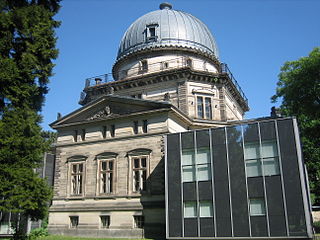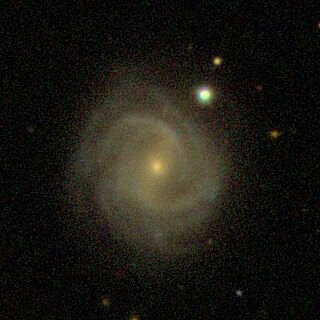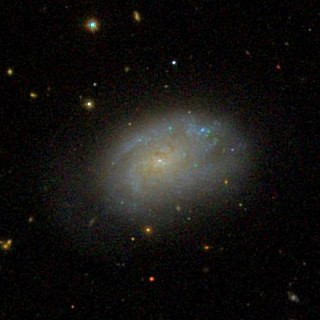Related Research Articles

SIMBAD is an astronomical database of objects beyond the Solar System. It is maintained by the Centre de données astronomiques de Strasbourg (CDS), France.

NGC 2503 is an isolated spiral galaxy approximately 254 million light-years away in the constellation Cancer. The galaxy was discovered on February 17, 1865 by astronomer Albert Marth.

NGC 4459 is a lenticular galaxy located about 50 million light-years away in the constellation of Coma Berenices. NGC 4459 is also classified as a LINER galaxy. NGC 4459 was discovered by astronomer William Herschel on January 14, 1787. NGC 4459 is a member of the Virgo Cluster.

NGC 4606 is a spiral galaxy located about 55 million light-years away in the constellation of Virgo. NGC 4606 was discovered by astronomer William Herschel on March 15, 1784. It has a disturbed stellar disk suggesting the actions of gravitational interactions. NGC 4607 may be a possible companion of NGC 4606. However, their redshifts differ by about 600 km/s, making it unlikely that they are a gravitationally bound pair. NGC 4606 is a member of the Virgo Cluster.

NGC 1019 is a barred spiral galaxy approximately 316 million light-years away from Earth in the constellation of Cetus. It was discovered by French astronomer Édouard Stephan on December 1, 1880 with the 31" reflecting telescope at the Marseille Observatory.

NGC 5609 is a spiral galaxy located 1.3 billion light-years light-years away from Earth, in the constellation Boötes. It has the second largest redshift of any galaxy in the New General Catalogue. Only NGC 1262, another spiral galaxy, has a higher redshift. NGC 5609 was discovered by astronomer Bindon Blood Stoney on March 1, 1851.

NGC 1190 is a lenticular galaxy approximately 109 million light-years away from Earth in the constellation of Eridanus. It was discovered by American astronomer Francis Leavenworth on December 2, 1885 with the 26" refractor at Leander McCormick Observatory.

NGC 1191 is a lenticular galaxy approximately 406 million light-years away from Earth in the constellation of Eridanus. It was discovered by American astronomer Francis Leavenworth on December 2, 1885 with the 26" refractor at Leander McCormick Observatory.

NGC 4528 is a barred lenticular galaxy located about 50 million light-years away in the constellation Virgo. It was discovered by astronomer William Herschel on March 15, 1784. The galaxy is a member of the Virgo Cluster.

NGC 1192 is a lenticular galaxy approximately 417 million light-years away from Earth in the constellation of Eridanus. It was discovered by American astronomer Francis Leavenworth on December 2, 1885 with the 26" refractor at Leander McCormick Observatory.

NGC 4595 is a spiral galaxy located about 42 million light-years away in the constellation Coma Berenices. NGC 4595 was discovered by astronomer William Herschel on January 14, 1787. NGC 4595 is a member of the Virgo Cluster.

NGC 4598 is a barred lenticular galaxy located in the constellation Virgo. NGC 4598 was discovered by astronomer William Herschel on April 15, 1784. The distance to NGC 4598 has not been accurately determined; measurements vary from 64 to 102 million light-years. According to the NASA/IPAC Extragalactic Database, its redshift based distance is 102 Mly (31.3 Mpc) while its redshift independent based distance is 88.71 Mly (27.200 Mpc). Also, according to SIMBAD, its distance is 63.7 Mly (19.54 Mpc). NGC 4598's average distance is 84.8 Mly (26.0 Mpc). NGC 4598 is usually considered to be a member of the Virgo Cluster. However, P. Fouqu´e et al. suggests it may be a background galaxy independent of the main cluster.

NGC 4659 is a lenticular galaxy located about 54 million light-years away in the constellation Coma Berenices. NGC 4659 was discovered by astronomer William Herschel on April 12, 1784 and is a member of the Virgo Cluster.

NGC 4876 is an elliptical galaxy located about 325 million light-years away in the constellation Coma Berenices. NGC 4876 was discovered by astronomer Guillaume Bigourdan on May 16, 1885. NGC 4876 is a member of the Coma Cluster.

NGC 3816 is a lenticular galaxy located about 270 million light-years away in the constellation Leo. It was discovered by astronomer Heinrich d'Arrest on May 9, 1864. NGC 3816 is a member of the Leo Cluster.

NGC 4207 is a spiral galaxy located about 50 million light-years away in the constellation Virgo. The galaxy was discovered by astronomer Heinrich d'Arrest on March 23, 1865. NGC 4207 is a member of the Virgo Cluster.

NGC 688 is a barred spiral galaxy with starburst activity located 190 million light-years away in the constellation Triangulum. It was discovered by astronomer Heinrich d'Arrest on September 16, 1865 and is a member of the galaxy cluster Abell 262.

NGC 4056 is an elliptical galaxy located about 340 million light-years away in the constellation Coma Berenices. The galaxy was discovered by astronomer Albert Marth on March 18, 1865 and is a member of the NGC 4065 Group.
The Telescopium−Grus Cloud is a galaxy filament in the constellations of Pavo, Indus, and Telescopium. It was first defined by astronomer Brent Tully in his book The Nearby Galaxies Atlas and its companion book The Nearby Galaxies Catalog.

NGC 4999 is a barred spiral galaxy located in the constellation Virgo, first discovered February 24, 1786 by astronomer William Herschel. The galaxy is noted as a particularly bright ultraviolet light source – it is believed that its notable bar structure suppresses star formation, indicating this ultraviolet light may possibly be due to a quasi-stellar object.
References
- ↑ "Infrared Processing and Analysis Center". www.ipac.caltech.edu. Retrieved November 13, 2022.
- ↑ "NASA Exoplanet Archive". Cal Tech. Retrieved November 13, 2022.
- ↑ "NASA Exoplanet Archive - a Service of the NASA Exoplanet Science Institute". Cal Tech. Retrieved November 13, 2022.
- ↑ "2 Micron All Sky Survey" . Retrieved November 13, 2022.
- ↑ "DSS Data Collection Atlas". irsa.ipac.caltech.edu. Retrieved 2022-11-13.
- ↑ "What's New with NED". Cal Tech. Retrieved November 13, 2022.